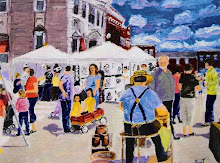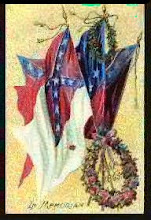Our History Helps Explain the Mystery...
...the Gallatin Ghost Walk intertwines the diverse history of Sumner County with spine-tingling stories of haunts and mysterious happenings.
We are not a 'spookhouse' venue. There are no scary masks or gory characters.
Our presenters do dress in period attire.
We walk the Square and several blocks surrounding the Square, treating guests to stories of old Sumner County and her 'spirits.'
Slow down, take a walk with us and see things you don't see when you are driving hurriedly by... you might even see a 'ghost'.... some of our guests have!
Welcome....
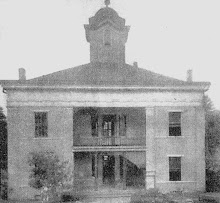
...to the Most Haunted Public Square in America!
Benefits of Local Historic Districts
The following guidelines are excerpted and adapted from Maintaining Community Character: How to Establish a Local Historic District by Pratt Cassity of the National Trust for Historic Preservation
--Local districts protect the investments of owners and residents. Historic district status is a marketing tool for real estate agents.
--Local districts are a record of our communities, ourselves, and our stories
-- Local districts can result in positive economic impact from tourism. A historic district that is aesthetically cohesive and well promoted can be a community's most important attraction= good economic sense for any city.
-- The protection of local historic districts can enhance business recruitment potential. Companies continually relocate to communities that offer their workers a higher quality of life which is greatly enhanced by successful local preservation programs and stable historic districts.
-- Local districts provide social and psychological benefits. A sense of empowerment and confidence develops when community decisions are made through a structured participatory process that recognizes the identity and integrity of neighborhoods.
-- There is less crime and blight when a defined area bands together to protect "our" neighborhood.
NOTE: Listing a property on the National Register of Historic places is honorary and does not offer protection from insensitive exterior changes or demolition.
That is one reason LOCAL protection of neighborhoods and structure is so important.
Even though we have many homes and businesses in Gallatin listed on the National Register of Historic Places, these structures, without LOCAL designation and protection, can be torn down at any time.
--Local districts protect the investments of owners and residents. Historic district status is a marketing tool for real estate agents.
--Local districts are a record of our communities, ourselves, and our stories
-- Local districts can result in positive economic impact from tourism. A historic district that is aesthetically cohesive and well promoted can be a community's most important attraction= good economic sense for any city.
-- The protection of local historic districts can enhance business recruitment potential. Companies continually relocate to communities that offer their workers a higher quality of life which is greatly enhanced by successful local preservation programs and stable historic districts.
-- Local districts provide social and psychological benefits. A sense of empowerment and confidence develops when community decisions are made through a structured participatory process that recognizes the identity and integrity of neighborhoods.
-- There is less crime and blight when a defined area bands together to protect "our" neighborhood.
NOTE: Listing a property on the National Register of Historic places is honorary and does not offer protection from insensitive exterior changes or demolition.
That is one reason LOCAL protection of neighborhoods and structure is so important.
Even though we have many homes and businesses in Gallatin listed on the National Register of Historic Places, these structures, without LOCAL designation and protection, can be torn down at any time.
Flurry of Orbs

Franklin Street, Gallatin
Tours year-round by appointment
Call 615-512-5299
Seances Popular in Victorian Times

for the first time in history, people had 'leisure' time; board games and a fascination with the occult were parlor pasttimes
Victorian Peculiarities

Phrenology - the study of the bumps and ridges in the human skull to "read" character, personality
Sex, Workaholism, Monomania, Murder . . . in 1920s Gallatin
Miscarriage of Justice, by Kip Gayden
Available at Treasure Island Books on the Square in Gallatin
Excellent Historical Fiction and Courtroom Drama
While the book is basically historical fiction, it is based on actual events in Gallatin and Nashville, involving
Anna (Dennis) Dotson and her husband, Dr. Walter Dotson.
They had been madly in love and wildly happy until Anna has a miscarriage, causing Walter's attentions to wane. The book is an excellent study on the human condition and how a family that appears on the surface to have everything can be hiding all sorts of secrets.
-- for full review of Book Miscarriage of Justice, by Kip Hayden see: http://afterdarkstudio.com/books/amazon_products_feed.cgi?Operation=ItemLookup&myOperation=CustomerReviews&ItemId=159995687X#review_4 Carol
Available at Treasure Island Books on the Square in Gallatin
Excellent Historical Fiction and Courtroom Drama
While the book is basically historical fiction, it is based on actual events in Gallatin and Nashville, involving
Anna (Dennis) Dotson and her husband, Dr. Walter Dotson.
They had been madly in love and wildly happy until Anna has a miscarriage, causing Walter's attentions to wane. The book is an excellent study on the human condition and how a family that appears on the surface to have everything can be hiding all sorts of secrets.
-- for full review of Book Miscarriage of Justice, by Kip Hayden see: http://afterdarkstudio.com/books/amazon_products_feed.cgi?Operation=ItemLookup&myOperation=CustomerReviews&ItemId=159995687X#review_4 Carol
Gallatin and Sumner County Helped Forge a New Nation
A 1913 account of the early pioneers of Sumner County:
"The historical interest attaching to any given locality in the United States is governed by what that locality has suffered for, and contributed to, the building of the Nation and the development of its policies and resources.
The territory now within the counties of Davidson and Sumner measures up to the full requirements of this standard."
"The Nashville-Gallatin Interurban pierces the very heart of a narrow strip of country 80 miles long and not over six miles wide which formed the nucleus of the Cumberland settlement.
This entire section was covered by a dense growth of cane fifteen feet high - an almost impenetrable labyrinth, broken only here and there by buffalo trails between the various licks. From this ambuscade the Indians shot the pioneers as the filed along the narrow paths or drank from the limpid streams. Even nature seemed to favor the red man in his fight to retain the primeval forest. . . . "
The complete article:
http://freepages.folklore.rootsweb.ancestry.com/~nashvillearchives/incident1.html
"The historical interest attaching to any given locality in the United States is governed by what that locality has suffered for, and contributed to, the building of the Nation and the development of its policies and resources.
The territory now within the counties of Davidson and Sumner measures up to the full requirements of this standard."
"The Nashville-Gallatin Interurban pierces the very heart of a narrow strip of country 80 miles long and not over six miles wide which formed the nucleus of the Cumberland settlement.
This entire section was covered by a dense growth of cane fifteen feet high - an almost impenetrable labyrinth, broken only here and there by buffalo trails between the various licks. From this ambuscade the Indians shot the pioneers as the filed along the narrow paths or drank from the limpid streams. Even nature seemed to favor the red man in his fight to retain the primeval forest. . . . "
The complete article:
http://freepages.folklore.rootsweb.ancestry.com/~nashvillearchives/incident1.html
Luke Blackburn

Kennesaw Stud
Kennesaw Horse Farm: famous stock
LUKE BLACKBURN (c. 1877 out of Nevada by Lexington) was bred by Capt. James Franklin of the Kennesaw Stud, Gallatin, Tennessee. He was considered one of the best runners of his era, and the champion at 3. He retired with 25 wins in 39 starts and $49,460, leading his sire to the top of the sires' standings in 1880. Luke Blackburn retired to stud at Belle Meade to replace his sire (who died in 1880), where he died in 1904. His most important offspring was the brilliant 2-year-old Proctor Knott, winner of the first Futurity Stakes; also American Derby winner Uncle Bob (named for Belle Meade's well-known stud groom), and the mare Heartburn.
The Palace Theatre
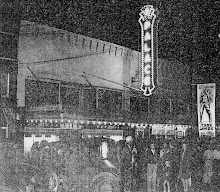
Opened in 1913 and considered at the time to be the premiere silent movie house in the South, the Palace is an architectural beauty, now gloriously restored. William Roth and his son operated the theatre for 64 years. Their 'presences' were felt throughout the restoration and even today.
Cragfont

...rivals the Myrtles Plantation in Louisiana as one of the most haunted homes in America
Attack on Ft. Donelson, TN
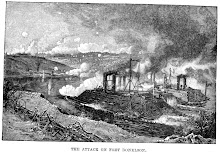
When Ft. D fell, the gate was wide open for the Union to occupy Gallatin and all of Middle Tennessee
Gallatin Women During the War Between the States
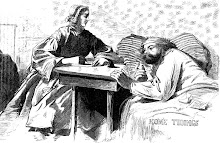
Virtually every public building and many homes were hospitals for the wounded
Emily Peyton

c.1854; daughter of Bailie Peyton was an illustrious woman in her own right
Gallatin Public Square
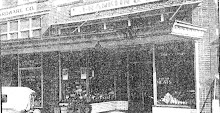
c. 1930
A Visit to the Centennial Exhibition in Nashville 1897
Memoirs of Judge Hickman of Nashville, Metro/Davidson County Archives
http://freepages.history.rootsweb.ancestry.com/~nashvillearchives/hickman.html
The Tennessee Centennial celebration was held in Nashville in 1897. The one hundredth anniversary of statehood was the year 1896. But owing to the magnitude of the task of preparation, it could not be gotten ready until the following year.
The grounds were laid out and the building erected in the area, which is now Centennial Park.
The Centennial Celebration was a great event for Nashville. Foreign nations were represented by buildings and exhibits.
There were exhibits of Agriculture, Labor, Commerce, Transportation, Education, Horticulture and dozens of others of great interest and beauty. The hundreds of incandescent lights that, as an old timer remarked, "Lit up the Heaven" were awe inspiring, in comparison to the flickering gas lights of the previous years.
The greatest orchestras and bands of America appeared in turn, for afternoon and evening concerts. Victor Herbert was booked for an engagement, and at each performance he not only conducted, but obliged the huge audiences with beautiful cello solos.
Gaiety reigned from May until September. There was a section called, "The Streets of Cairo," with Hoochy Koochy dancers, wild barbaric music, camel and elephant rides with attendants in native dress.
This was denounced as a den of iniquity by the ministers and the uplift organizations. Their adverse criticism caused a great up surge in the gate receipts.
There was a Shoot the Chute. This was a long inclined run way with a canoe tethered at its highest point of elevation. When the canoe was filled with its quota of intrepid voyagers, it was unleashed, and plunging and careening madly down the slide, shot off across the lake. It was a Thriller. Shrieks rent the air, and many reached the shore in a state of collapse. It must have been patronized by a good many elderly people. When the lake drained, several sets of dentures were recovered from its muddy bottom.
http://freepages.history.rootsweb.ancestry.com/~nashvillearchives/hickman.html
The Tennessee Centennial celebration was held in Nashville in 1897. The one hundredth anniversary of statehood was the year 1896. But owing to the magnitude of the task of preparation, it could not be gotten ready until the following year.
The grounds were laid out and the building erected in the area, which is now Centennial Park.
The Centennial Celebration was a great event for Nashville. Foreign nations were represented by buildings and exhibits.
There were exhibits of Agriculture, Labor, Commerce, Transportation, Education, Horticulture and dozens of others of great interest and beauty. The hundreds of incandescent lights that, as an old timer remarked, "Lit up the Heaven" were awe inspiring, in comparison to the flickering gas lights of the previous years.
The greatest orchestras and bands of America appeared in turn, for afternoon and evening concerts. Victor Herbert was booked for an engagement, and at each performance he not only conducted, but obliged the huge audiences with beautiful cello solos.
Gaiety reigned from May until September. There was a section called, "The Streets of Cairo," with Hoochy Koochy dancers, wild barbaric music, camel and elephant rides with attendants in native dress.
This was denounced as a den of iniquity by the ministers and the uplift organizations. Their adverse criticism caused a great up surge in the gate receipts.
There was a Shoot the Chute. This was a long inclined run way with a canoe tethered at its highest point of elevation. When the canoe was filled with its quota of intrepid voyagers, it was unleashed, and plunging and careening madly down the slide, shot off across the lake. It was a Thriller. Shrieks rent the air, and many reached the shore in a state of collapse. It must have been patronized by a good many elderly people. When the lake drained, several sets of dentures were recovered from its muddy bottom.
A Young Man's Life at Gallatin's Transmontania Academy
Robert Vinson; buried in Gallatin City Cemetery
"I could relate many pleasant incidents of boyhood days, but must pass to March, 1856, when my father took me (from Louisiana) to Tennessee to go to school.
We made the entire trip from New Orleans to Nashville on the same steam boat.
Though twelve years old I do not remember much of the trip.
We made the trip from Nashville to Gallatin by Stage, but I don't know much about it, and don't remember how I met, or was received by my Aunts, but of course, it must have been with kindness.
I boarded with my Aunt Patsy Gray during the entire time of over two years, and it was a pleasant and agreeable home all the while. Their son, Frank Gray, two years older than me went to the same school at the same time.
The teacher was Dr. W. W. Lambain, who was from Baltimore. He was very strict and often whipped some scholar for failing in their lessons.
Nearly all that I know, in the commoner branches of education was at that school, called the "Transmontania Academy".
It was quite a little walk from Aunt Patsy's (Martha) to the school. There was no bridge over the town creek in those days and we had to cross on a large foot log.
My father remained in Gallatin all that summer, as it was his first visit in eight years, since leaving Tennessee in 1848, and it proved to be his last.
I had accounts at one or two stores, where I could get such things as needed.
I went to Sunday School and very often to Church with the family.
I did not go over to town much and very seldom at night."
"I could relate many pleasant incidents of boyhood days, but must pass to March, 1856, when my father took me (from Louisiana) to Tennessee to go to school.
We made the entire trip from New Orleans to Nashville on the same steam boat.
Though twelve years old I do not remember much of the trip.
We made the trip from Nashville to Gallatin by Stage, but I don't know much about it, and don't remember how I met, or was received by my Aunts, but of course, it must have been with kindness.
I boarded with my Aunt Patsy Gray during the entire time of over two years, and it was a pleasant and agreeable home all the while. Their son, Frank Gray, two years older than me went to the same school at the same time.
The teacher was Dr. W. W. Lambain, who was from Baltimore. He was very strict and often whipped some scholar for failing in their lessons.
Nearly all that I know, in the commoner branches of education was at that school, called the "Transmontania Academy".
It was quite a little walk from Aunt Patsy's (Martha) to the school. There was no bridge over the town creek in those days and we had to cross on a large foot log.
My father remained in Gallatin all that summer, as it was his first visit in eight years, since leaving Tennessee in 1848, and it proved to be his last.
I had accounts at one or two stores, where I could get such things as needed.
I went to Sunday School and very often to Church with the family.
I did not go over to town much and very seldom at night."
Fairvue

...elegant reminder of plantation days in Sumner County
Sumner County 1861
Snapshot Sumner County - 1861
Population 22,030 14,227 White
7,700 Black slaves 103 Free Blacks
Gallatin was the largest city in the County with pop. 2,000
During the Union occupation of Gallatin, 1862-1867 as many as 3000 Union soldiers were encamped at one time in the City, with headquarters in the Courthouse
What is now Trousdale County was a part of Sumner County
Agriculture
Most of the county was farm land growing tobacco, corn, food grains and some cotton.
Sumner County was a major pork producer, with cattle, sheep and poultry also important.
Horse breeding of thoroughbreds was very important with the County being famous for its horses, and its hunting dogs
Manufacturing
Cotton mills, flour mills, harness making, blacksmithing and saw mills
The county’s largest manufacturer was the carriage works located on East Main street across from Captain D’s (that building is still there)
Business
Most stores and other businesses were located around the public square and on Water Street, Franklin and Smith Streets
Professions
Many Doctors and lawyers practiced in Gallatin and there were enough cases being heard in the Courts to support several hotels and boardinghouses
Newspapers
2 weekly newspapers
The Examiner - was strongly Democratic and became the News-Examiner of today
The Courier and Enquirer - Pro-slavery but strongly Unionist
Churches
Presbyterian, Methodist and Baptist
Schools
Howard Female Institute
Transmountania Male Academy
Roads
Nashville - Hopkinsville Pike (U.S. 31 E)
Hartsville Pike (TN 25)
Railroads
Louisville and Nashville (L&N) connecting Nashville with Bowling Green and Louisville, Kentucky with a depot and rail yard in Gallatin
Prominent Citizens
William Trousdale, former Tennessee Governor lived 2 blocks west of the Public Square on Main Street; his house still stands, and the grounds contain a Confederate monument .
Usually the Confederate monuments are on the Courthouse square in the South, making Sumner County’s an unusual placement, but the Trousdales are a family of War heroes, from Colonial times forward. Mrs. Trousdale left the house to a lineage society with instructions that it actively honor the veterans of all wars, particularly the Confederate veterans. The house is today used primarily as a rental hall for private parties. Trousdale and many of his family members are buried in Gallatin City Cemetery.
Josephus Conn Guild was an attorney with an extensive practice throughout middle Tennessee and served as Chancery Court Judge.
Alfred R. Wynne, a planter and horse breeder, lived at Wynnewood in Castalian Springs. The house was built in 1820 but sadly was heavily damaged in the 2008 tornadoes.
William B. Bate, Castalian Springs lawyer and state legislator became a Confederate General.
Bailie Peyton, former U.S. Congressman, was offered the Secretary of War position by President Taylor, but he declined, preferring to serve as Ambassador to Chile with his daughter Emily (pictured above right) as his personal assistant, an unusual position for a woman in those times.
Peyton was a strong Unionist. His horse plantation, Peytona, stood where Vol State is now. The family cemetery was razed and paved over, along with the mansion.
Joseph Smith Fowler was President of the Howard Female Institute. A staunch Unionist from Ohio, he left Gallatin in early 1861 because of the threat of secession.
Secession
In February 1861 the first vote was held on the question of holding a convention to decide whether Tennessee should remain in the Union or join the growing number of southern states that were forming the Confederacy.
The Vote was held on February 9, 1861 across Tennessee. The measure was defeated statewide but the vote in Sumner County showed 1,535 to 770 in favour of the convention.
Governor Isham Harris asked the legislature to vote for Southern independence on April 25. This vote was ratified by the people in a referendum held on June 4, 1861.
On July 22, 1861 Tennessee officially joined the Confederacy.
In Sumner County the secession question divided families and friends.
Alfred Wynne of Wynnewood was strongly Unionist yet his son Val became a Lieutenant in the Confederate Army
Bailie Peyton, Sr. also supported the Union but his son and law partner, Balie Peyton, Jr. joined the Confederate Army becoming a Lieutentant in the Hickory Guards raised in Nashville. Father and son never again spoke to one another.
Peyton, Sr. and Josephus Conn Guild were friends and partners in the horse breeding for 40 years but were divided by the secession question and ended their friendship.
Population 22,030 14,227 White
7,700 Black slaves 103 Free Blacks
Gallatin was the largest city in the County with pop. 2,000
During the Union occupation of Gallatin, 1862-1867 as many as 3000 Union soldiers were encamped at one time in the City, with headquarters in the Courthouse
What is now Trousdale County was a part of Sumner County
Agriculture
Most of the county was farm land growing tobacco, corn, food grains and some cotton.
Sumner County was a major pork producer, with cattle, sheep and poultry also important.
Horse breeding of thoroughbreds was very important with the County being famous for its horses, and its hunting dogs
Manufacturing
Cotton mills, flour mills, harness making, blacksmithing and saw mills
The county’s largest manufacturer was the carriage works located on East Main street across from Captain D’s (that building is still there)
Business
Most stores and other businesses were located around the public square and on Water Street, Franklin and Smith Streets
Professions
Many Doctors and lawyers practiced in Gallatin and there were enough cases being heard in the Courts to support several hotels and boardinghouses
Newspapers
2 weekly newspapers
The Examiner - was strongly Democratic and became the News-Examiner of today
The Courier and Enquirer - Pro-slavery but strongly Unionist
Churches
Presbyterian, Methodist and Baptist
Schools
Howard Female Institute
Transmountania Male Academy
Roads
Nashville - Hopkinsville Pike (U.S. 31 E)
Hartsville Pike (TN 25)
Railroads
Louisville and Nashville (L&N) connecting Nashville with Bowling Green and Louisville, Kentucky with a depot and rail yard in Gallatin
Prominent Citizens
William Trousdale, former Tennessee Governor lived 2 blocks west of the Public Square on Main Street; his house still stands, and the grounds contain a Confederate monument .
Usually the Confederate monuments are on the Courthouse square in the South, making Sumner County’s an unusual placement, but the Trousdales are a family of War heroes, from Colonial times forward. Mrs. Trousdale left the house to a lineage society with instructions that it actively honor the veterans of all wars, particularly the Confederate veterans. The house is today used primarily as a rental hall for private parties. Trousdale and many of his family members are buried in Gallatin City Cemetery.
Josephus Conn Guild was an attorney with an extensive practice throughout middle Tennessee and served as Chancery Court Judge.
Alfred R. Wynne, a planter and horse breeder, lived at Wynnewood in Castalian Springs. The house was built in 1820 but sadly was heavily damaged in the 2008 tornadoes.
William B. Bate, Castalian Springs lawyer and state legislator became a Confederate General.
Bailie Peyton, former U.S. Congressman, was offered the Secretary of War position by President Taylor, but he declined, preferring to serve as Ambassador to Chile with his daughter Emily (pictured above right) as his personal assistant, an unusual position for a woman in those times.
Peyton was a strong Unionist. His horse plantation, Peytona, stood where Vol State is now. The family cemetery was razed and paved over, along with the mansion.
Joseph Smith Fowler was President of the Howard Female Institute. A staunch Unionist from Ohio, he left Gallatin in early 1861 because of the threat of secession.
Secession
In February 1861 the first vote was held on the question of holding a convention to decide whether Tennessee should remain in the Union or join the growing number of southern states that were forming the Confederacy.
The Vote was held on February 9, 1861 across Tennessee. The measure was defeated statewide but the vote in Sumner County showed 1,535 to 770 in favour of the convention.
Governor Isham Harris asked the legislature to vote for Southern independence on April 25. This vote was ratified by the people in a referendum held on June 4, 1861.
On July 22, 1861 Tennessee officially joined the Confederacy.
In Sumner County the secession question divided families and friends.
Alfred Wynne of Wynnewood was strongly Unionist yet his son Val became a Lieutenant in the Confederate Army
Bailie Peyton, Sr. also supported the Union but his son and law partner, Balie Peyton, Jr. joined the Confederate Army becoming a Lieutentant in the Hickory Guards raised in Nashville. Father and son never again spoke to one another.
Peyton, Sr. and Josephus Conn Guild were friends and partners in the horse breeding for 40 years but were divided by the secession question and ended their friendship.
Rosemont
Historic Home of Judge Guild




